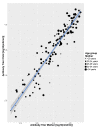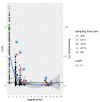Waning of Maternal Antibodies against Measles Suggests a Large Window of Susceptibility in Infants in Lao People's Democratic Republic
- PMID: 34684265
- PMCID: PMC8538652
- DOI: 10.3390/pathogens10101316
Waning of Maternal Antibodies against Measles Suggests a Large Window of Susceptibility in Infants in Lao People's Democratic Republic
Abstract
Introduction: Measles is an endemic but largely neglected disease in Lao People's Democratic Republic. New-borns are protected by maternal antibodies, but antibody waning before measles vaccination at 9 months of age leaves infants susceptible to infection. In this study, the susceptibility window of infants was determined to generate scientific evidence to assess the national measles immunization strategy.
Methods: Between 2015 and 2016, demographic data, medical history, and blood samples were collected from 508 mother-child pairs at the provincial hospital in Vientiane. The samples were screened with a commercial kit detecting anti-measles IgG antibodies.
Results: The large majority (95.7%) of the mothers were seropositive for anti-measles IgG and antibody titers of the mothers and infants were highly correlated (p < 0.01). While at birth 97.7% of the infants were seropositive, seropositivity rates decreased to 74.2% two months later to reach only 28.2% four months after birth (p < 0.01). Just before the first dose of the measles-rubella vaccine, scheduled at 9 months of age, was actually given, less than 14% of the infants were seropositive.
Conclusion: This alarmingly wide susceptibility gap due to rapid maternal antibody decay leaves infants at risk of measles infection and serious disease complications. A high herd immunity is crucial to protect young infants and can be achieved through improved routine vaccination coverage and (expanded age group) supplementary immunization activities.
Keywords: Lao PDR; maternal antibodies; measles; seropositivity; waning.
Conflict of interest statement
The authors declare that they have no conflict of interest.
Figures


Similar articles
-
[Prevalence of maternal measles, rubella, mumps and varicella antibodies in the first six months of life].Mikrobiyol Bul. 2018 Jul;52(3):324-327. doi: 10.5578/mb.67169. Mikrobiyol Bul. 2018. PMID: 30156519 Turkish.
-
Seroprevalence of measles and rubella antibodies in vaccinated and unvaccinated infants in the Lao People's Democratic Republic.Int J Infect Dis. 2021 Jul;108:524-530. doi: 10.1016/j.ijid.2021.06.016. Epub 2021 Jun 10. Int J Infect Dis. 2021. PMID: 34119678
-
Evaluation of nationwide supplementary immunization in Lao People's Democratic Republic: Population-based seroprevalence survey of anti-measles and anti-rubella IgG in children and adults, mathematical modelling and a stability testing of the vaccine.PLoS One. 2018 Mar 29;13(3):e0194931. doi: 10.1371/journal.pone.0194931. eCollection 2018. PLoS One. 2018. PMID: 29596472 Free PMC article.
-
Susceptibility to Vaccine-Preventable Diseases in Four Districts of Xaysomboun Province, Lao People's Democratic Republic.Vaccines (Basel). 2022 Mar 17;10(3):463. doi: 10.3390/vaccines10030463. Vaccines (Basel). 2022. PMID: 35335095 Free PMC article.
-
Reviewing of Research Finding of Hepatitis B Virus Infection in Lao People's Democratic Republic.Euroasian J Hepatogastroenterol. 2018 Jan-Jun;8(1):75-76. doi: 10.5005/jp-journals-10018-1265. Epub 2018 May 1. Euroasian J Hepatogastroenterol. 2018. PMID: 29963469 Free PMC article. Review.
Cited by
-
Epidemiological and Clinical Characteristics of Measles in Jinan, Shandong Province, China, from 1991 to 2022.Int J Gen Med. 2023 Jun 6;16:2305-2312. doi: 10.2147/IJGM.S407121. eCollection 2023. Int J Gen Med. 2023. PMID: 37304905 Free PMC article.
-
The Unprotected: Measles Seroprevalence in Children During the First Two Years of Life.Viruses. 2025 Jul 11;17(7):973. doi: 10.3390/v17070973. Viruses. 2025. PMID: 40733590 Free PMC article.
-
Use of an ETEC Proteome Microarray to Evaluate Cross-Reactivity of ETVAX® Vaccine-Induced IgG Antibodies in Zambian Children.Vaccines (Basel). 2023 May 4;11(5):939. doi: 10.3390/vaccines11050939. Vaccines (Basel). 2023. PMID: 37243042 Free PMC article.
-
Pre- and Post-Vaccination Measles Antibody and Persistence Up to 5 Years of Age Among Early ART-Treated HIV-Infected, HIV-Exposed Uninfected and HIV-Unexposed Children in Cameroon.Vaccines (Basel). 2025 May 30;13(6):584. doi: 10.3390/vaccines13060584. Vaccines (Basel). 2025. PMID: 40573915 Free PMC article.
-
Serosurveillance for Measles and Rubella.Vaccines (Basel). 2024 Jul 22;12(7):816. doi: 10.3390/vaccines12070816. Vaccines (Basel). 2024. PMID: 39066453 Free PMC article. Review.
References
-
- World Health Organization Table 2: Summary of WHO Position Papers—Recommended Routine Immunizations for Children (Updated September 2020) 2019. [(accessed on 13 August 2021)]. Available online: https://www.who.int/immunization/policy/Immunization_routine_table2.pdf.
-
- World Health Organization Measles vaccines: WHO position paper—April 2017. Wkly. Epidemiol. Rec. 2017;92:205–227. - PubMed
Grants and funding
LinkOut - more resources
Full Text Sources
Miscellaneous

